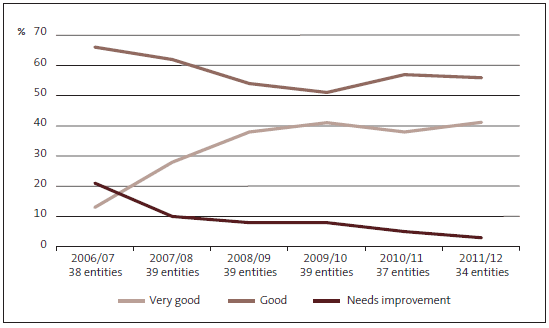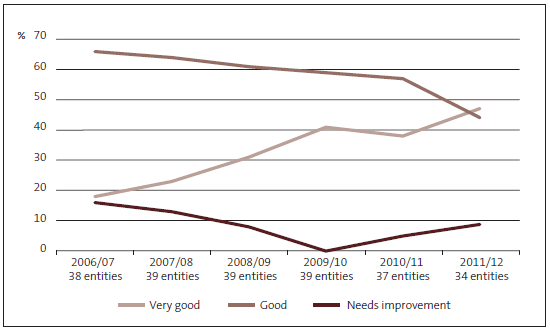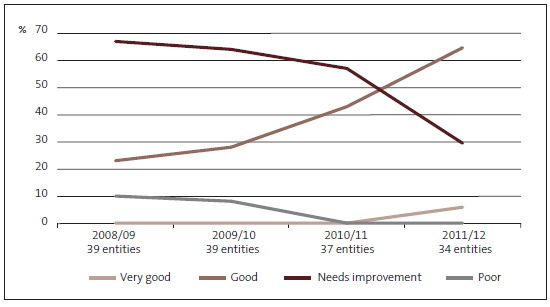Part 6: Results of government department audits
6.1
In this Part, we report on the audit results of government departments in 2011/12, including our assessments of their management control environments, financial information systems, and service performance information and associated systems and controls.
Audit reports for 2011/12
6.2
We audited 40 government departments in 2011/12. These included:
- 32 public service departments (four of the audits were final audits for departments disestablished on 1 July 2012);
- six non-public service departments; and
- two Offices of Parliament (the Office of the Ombudsman and the Office of the Parliamentary Commissioner for the Environment).
6.3
The 40 audits included the final audits for four departments that were disestablished on 1 July 2012.
6.4
We issued unmodified opinions for all 40 government departments for the year ended 30 June 2012.
6.5
We also issued opinions for 12 trusts and funds overseen by government departments. We expressed an adverse opinion for two of these entities on the basis that they did not recognise their museum collection assets or the associated depreciation expense:
- Royal New Zealand Navy Museum Trust Incorporated (for the two years ended 30 June 2011 and 30 June 2012); and
- RNZAF Museum Trust Board.
6.6
These opinions did not affect the opinion we issued for the New Zealand Defence Force.
Observations and matters arising from the audits
6.7
During our audit work, we gain insights and perspectives on the various factors and challenges facing public entities and about the initiatives for responding to these and driving improvement. In this Part, we set out some of our observations and matters raised by auditors working with government departments.
Final audits for departments that were disestablished
6.8
We carried out final audits for four departments that were disestablished on 1 July 2012 and amalgamated to form the new MBIE. The four departments were the:
- Ministry of Economic Development;
- Ministry of Science and Innovation;
- Department of Labour; and
- Department of Building and Housing.
6.9
For all four departments, our audit report included an explanatory paragraph highlighting that the financial statements were prepared on a disestablishment basis.
6.10
Our main considerations for disestablishment audits included:
- monitoring the control environment to identify emerging risks or issues, such as the loss of significant personnel and the effect of changes on staff morale, because risk of fraud, errors, and loss of core capability is often heightened during significant change processes and needs to be managed well;
- understanding and ensuring that appropriate delegations are in place through the transition period and for signing the statement of responsibility in the annual report;
- checking that relevant legislation was complied with, including the requirements associated with the disestablishment of the entities; and
- the appropriate treatment of assets, liabilities, and provisions.
6.11
Auditors also monitored for any indication of waste and lack of probity or financial prudence around severance, redundancy, and retention payments.
6.12
We did not assess the entities' environments, systems, and controls when we carried out the final audits. This is because the grades we give reflect our recommendations for improvement, and deficiencies identified in the final audit of an entity to be disestablished may or may not be relevant to any new entity.
6.13
However, we did report our audit findings and any significant issues to the responsible Minister, and we commented on the operation of the environment, systems, and controls during the disestablishment period.
6.14
Overall, our appointed auditors found that the four disestablished government departments maintained sound systems and controls until disestablishment.
Structural and organisational change
6.15
The 2011/12 year saw continued structural and organisational change within government departments. Our findings from disestablishment audits are discussed in paragraphs 6.8-6.14. Other organisational change has included executive team changes, national office restructures, and/or regional management changes. This work has continued through into 2012/13. Change has been driven by a range of factors, including:
- demand for improved results as signalled under BPS and the need to manage within existing financial baselines;
- changed business models and approaches to delivery; and
- mergers, both of functions and/or entities.
6.16
A number of departments are investing in modernising service delivery. In other cases, fiscal constraints have challenged and exposed issues around business models and pricing of services resulting in substantive reviews.
6.17
The Crown Law Office (CLO) and the Ministry of Justice are examples of entities that are currently implementing organisational change. In 2011/12, the CLO responded to a number of organisational reviews that were carried out during the previous year. There has been restructuring of the organisation and other initiatives aimed at improving financial management and overall governance. The Ministry of Justice has been working to refocus its national office structure, capability, and resources to better support delivery of a new business strategy and frontline services. This is discussed in the next section.
6.18
Periods of significant organisational change pose a risk to the maintenance of management systems and controls, and management needs to be vigilant to avoid potential slips in controls. Generally, we found that entities' controls were sound throughout their change processes.
6.19
If restructuring is expected to lead to savings, we have recommended that departments develop and implement systems to report on savings and where savings have been re-applied.
Business transformation programmes and projects
6.20
A number of departments are in the process of developing and implementing significant business transformation programmes. These often underpin organisation restructures discussed above. For example:
- Inland Revenue's Business Transformation Programme, if approved and funded by Cabinet, will involve major changes to the way Inland Revenue conducts its business, how or when it interacts with customers and associated parties, and how its technology platform performs to support operations.
- The Statistics New Zealand 2020 Te Kāpehu Whetū programme is an organisation-wide change programme to ensure that Statistics New Zealand can effectively lead the Official Statistics System in the future, get more value from official statistics by connecting more closely with users, and modernise the systems used by Statistics New Zealand to produce and disseminate statistics.
- The Ministry of Justice is implementing a number of programmes designed to modernise how it delivers court services – through greater use of technology (electronic operating model), better processes (Criminal Procedure Act 2011), and using its scale and resources more effectively (regional service delivery). These changes will have implications for the major players within the criminal justice sector: judiciary, constabulary, legal profession, court staff, and other users of court services.
6.21
Business transformation programmes can often involve developing and implementing core information systems that have inherent risks. These include, but are not limited to, the potential for significant cost overruns, system "bugs", and security breaches.
6.22
We monitor and stay abreast of developments through our audit work. The SSC monitors significant programmes.
Cost recovery through user charges
6.23
Fiscal constraints are challenging some departments to consider alternative revenue streams to fund service delivery. Cost recovery through user charges for some services is an option that some departments are considering. We intend to watch this area closely and will work with entities to ensure that they understand the requirements. We will also check on compliance with guidelines for setting charges and fees for public sector goods and services.
6.24
If government departments provide services on a full cost recovery basis, the department is required to operate a memorandum account to record the accumulated surplus or deficit arising from providing the service. The balance of each memorandum account should trend to zero over time.
6.25
We noted in our 2011/12 audit work that some departments' memorandum accounts have significant surpluses and others have significant deficits. For a more detailed overview of the issues, see Part 11. In 2012/13, we plan to review the processes that departments have in place to monitor the balances of memorandum accounts and to enquire into departments' plans to address significant deficits or surpluses.
Implications of the Canterbury earthquakes and other strengthening work
6.26
In Part 5, we noted how the uncertainties arising from the Canterbury earthquakes need to be considered when reviewing the financial and non-financial statements of CERA and EQC.
6.27
Beyond Canterbury, the vulnerability of government buildings to future earthquakes has been considered, with many public entities carrying out seismic strength assessments. This has seen earthquake-strengthening programmes put in place, the closure of some properties (some permanently), and property revaluation.
6.28
The financial statements of the Ministry of Education reflect the wider effect that the Canterbury earthquakes have had on government departments. The Ministry increased its provisions for impairments to the value of school buildings, increasing its provision for defective buildings by $94.6 million, bringing the total of the provision to $1.025 billion at 30 June 2012. However, unlike CERA and EQC, the Ministry received a standard audit report. This is because, although damage and future seismic strengthening costs have adversely affected its financial position:
- there is relative certainty over the expected future costs; and
- the associated provisions do not affect the "going concern" assumption.
6.29
The potential accounting implications associated with the Canterbury earthquake recovery include asset write-offs and recognition of impairment losses. Our appointed auditors will remain alert to these potential issues to ensure that the appropriate accounting treatment occurs.
Procurement
6.30
Our audit work confirms that procurement and the need to ensure that processes and systems are robust and fit for purpose was front of mind for many government departments. Those departments with significant procurement programmes carried out, or were in the process of implementing, reviews of procurement systems and processes.
6.31
For example, auditors have noted the reviews and subsequent changes that have been and are being carried out by the Ministry of Health, Inland Revenue, and the Ministry of Social Development.
6.32
The Ministry of Health's review of procurement and contracting processes has led to a number of recommendations to improve consistency in how its procurement and contracting processes are applied. An action plan to address recommendations arising from the review has been put in place.
6.33
Inland Revenue is implementing recommendations laid out in the PMMS Consulting Group's Procurement Capability Review Report, released in August 2010. We noted that Inland Revenue was making good progress and is well placed to implement changes to strengthen its procurement function.
6.34
The Ministry of Social Development has now introduced a standardised process across the unified procurement team. Templates and a procedures manual to support this are due to be finalised in the first quarter of 2013.
6.35
With fiscal constraints and a focus on better public services and value for money, procurement will continue to be an area of audit interest. Appointed auditors will assess entities' procurement processes by reviewing procurement policies and large contracts.
6.36
As part of our 2012/13 work programme, we are carrying out a performance audit to examine how effectively and efficiently CERA, NZTA, and the Christchurch City Council are managing to rebuild Christchurch's horizontal infrastructure through the Stronger Christchurch Infrastructure Rebuild Team. We are examining whether:
- the entities have appropriate strategic arrangements in place that promote effective and efficient procurement (in the context of post-disaster recovery); and
- operational project delivery is effective and efficient in the circumstances and, where trade-offs are necessary, they are made with the intent to support recovery from the Canterbury earthquakes.
Environment, systems, and controls
6.37
We assessed and graded the environment, systems, and controls for managing and reporting financial and service performance information for 34 government departments in 2011/12. We did not assess the four departments disestablished with effect from 1 July 2012, and the summary excludes the assessments for both the Government Communications Security Bureau and the New Zealand Security Intelligence Service. Figure 3 sets out a summary of the grades for departments from 2006/07 to 2011/12. See Appendix 1 for an explanation of the grading scale.
Management control environment
Figure 3
Management control environment – grades for the departments assessed from 2006/07 to 2011/12

6.38
Overall, the results for 2011/12 show that government departments have generally sound management control environments. Except for CERA, which was assessed as "Needs improvement", all other departments were assessed as either "Good" or "Very good". CERA's grade largely reflects its status as a newly established entity (15 months at the time of audit) that is setting up robust and consistently applied controls.
6.39
Over time, across government departments, controls have strengthened overall. The number of departments assessed as "Needs improvement" dropped to zero for established departments, and 41% of departments are now assessed as "Very good" compared with 13% in 2006/07.
6.40
However, it is useful to look at the assessment of individual entities over time because grades can move up and down. Grades fluctuate from year to year depending on several factors, such as changes in the operating environment, in standards, in good practice expectations, and in auditor emphasis. For example, a downward shift might not indicate deterioration. Instead, the entity might not have kept pace with best practice expectations for similar entities. Consequently, how an entity responds to the auditor's recommendation for improvement is important, and the long-term trend in grade movements is a more useful indication of progress than year-to-year movements.
Financial information systems and controls
6.41
Overall, our assessment of government departments' financial information systems and controls is positive (see Figure 4). In 2011/12, all but three departments were assessed as "Good" or "Very good".
Figure 4
Financial information systems and controls – grades for the departments assessed from 2006/07 to 2011/12

6.42
The three entities assessed as "Needs improvement" were:
- CERA – As noted in paragraph 6.37, CERA was still working to establish robust systems and processes at the time of audit.
- Parliamentary Service – The implementation process for the new financial information management system (FMIS) in 2010/11 was not as effective as expected. Therefore, we assessed Parliamentary Service's control environment as "Needs improvement". Although some progress has been made in addressing issues raised during the 2010/11 audit, there is further work to embed the system. On this basis, the grade remained "Needs improvement" in 2011/12.
- New Zealand Defence Force – The audit identified a number of areas with control deficiencies, including payroll, delegations, and accounting for property, plant, and equipment.
Service performance information and associated systems and controls
6.43
Figure 5 shows the results of our assessment of government departments' service performance information and associated systems and controls during the past four years. For the year ended 30 June 2012, 22 (65%) departments received a "Good" grade. For the first time, we can report that two departments, Inland Revenue and the Ministry for the Environment, received "Very good" grades for their service performance information and associated controls. "Needs improvement" grades were received by 10 (29%) departments compared with 21 (57%) for the previous year. No departments were graded "Poor".
Figure 5
Service performance information and associated systems and controls – grades for the departments assessed from 2008/09 to 2011/12

6.44
We noted the improvement in reporting performance information in our analysis of the 2010/11 audit results. We are pleased to see that departments have continued to work to improve their performance measurement frameworks and reporting in 2011/12.

